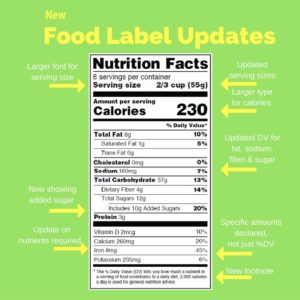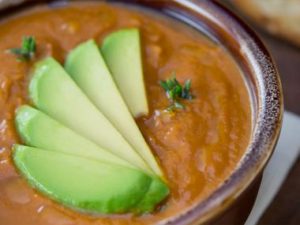|
Earlier this year the Food Drug Administration (FDA) took a significant step in finalizing the new and improved Nutrition Facts label for packaged foods sold in the United States. The FDA has taken a stance to revisit its labeling regulations of conventional foods to assist consumers in making better food choices.
As we come to the end of a presidential term, I wanted to highlight the work Michelle Obama has done for creating a healthier America. Part of the legacy she will leave is her involvement in with her involvement in Partnership for Healthier and “Let’s Move!” initiative. She is responsible for helping to improve overall food policy, school foods, eliminating trans fat, implementing calorie count on chain restaurants menu, and an overall positive progress for a healthier nation. Michelle Obama was instrumental in changes to the new Nutrition Facts label released May 20, 2016. I hope this newsletter helps to better inform you on what the updates mean, and how to apply them when making food choices.
|
|
|
|
| FUEL & NOURISH |
| New Nutrition Facts Label: 101 |

Compliance Dates
The effective date of the final rule was July 26, 2016. The compliance date for manufacturers with $10 million or more in annual food sales is July 26, 2018. Manufacturers with less than $10 million in annual food sales have until July 26, 2019 to comply. Even though the ruling passed, you won’t see new food labels for a few years, mid 2018 for most products and some not till 2019.
The goal
Claudine Kavanaugh, Ph.D., M.P.H., R.D., a health scientist at the FDA, stresses that the primary goal is not to tell consumers what they should be eating, but to expand and highlight the information they most need. “It’s all about providing information that people can use to make their own choices,” she says.
Key Changes
A huge debate emerged when the FDA first announced its plan to revise the label. Everyone, including consumers, scientists, and food lobbyists commented on the content and new design. Here are the highlights of the changes:
Refreshed Design
Calories: shown in a larger, bolder type. Serving size and number of servings per package: larger and easier to read on the label. Serving sizes will reflect common food portions. For example, the serving for ice cream will increase from half cup to two-thirds cup and for soda from eight ounces to twelve ounces. This change will help consumers make more informed decisions on the food portions they’re consuming.
Shift in Focus on Key Nutrients
Calories from Fat will be removed, and the emphasis will be on identifying the type of fat the food product provides, such as trans fat, saturated fat, polyunsaturated fat, or monounsaturated fat.
Vitamins A and C will no longer be mandatory. It will be up to food manufacturers to include these vitamins.
Vitamin D and potassium will be mandatory for inclusion on the new Nutrition Facts label by all manufacturers.
Highlight on Added Sugar
The new Daily Value for added sugars on the revised label is 50 grams, or about 12 teaspoons—an amount representing 10 percent of the daily 2,000 calories recommended for many adults. The current Nutrition Fact label does not differentiate how much sugar is added or naturally occurring. A big change on the label is identifying how many grams of total sugar are added sugar. Natural sugar is found in milk and yogurt (lactose) and fruit products (fructose). Added sugar includes brown sugar, honey, evaporated cane syrup, malt syrup, molasses, high fructose corn syrup, sucrose, and others. |
|
|
|
| WELLNESS NIBBLE |
| Daily Recommended Values Updated |

Daily Values (DV) for various nutrients such as dietary fiber, vitamin D, and sodium have been updated.
- Daily Value for sodium is decreased from 2,400 mg to 2,300 mg per day (even though many health institutions including the American Heart Association and Centers for Science in the Public Interest would have preferred an even lower Daily Value of 1,500 mg per day.)
- A DV has been set for sugar. This is a new recommendation, as there had not been a DV set for sugar in the past.
- Fiber recommendations changed from 25 grams to 28 grams per day emphasizing the need for Americans to increase overall fiber in their diet.
- Vitamin D recommendations increased from 10 mcg to 20 mcg.
- Potassium recommendations increased from 3,500 mg to 4,700 mg per day.
- Total fat recommendation increased from 65 grams to 78 grams per day, based on a 2000 calorie diet. However, the focus is to increase overall monounsaturated and polyunsaturated fats.
- Total recommended carbohydrate intake is reduced from 300 grams to 275 grams per day, based on a 2000 calorie diet.
|
|
|
|
| FEATURED RECIPE |
|
Creamy Avocado Tomato Soup |
 Recipe by: Avocado Central Recipe by: Avocado Central
Ingredients:
1 tablespoon olive oil
¾ cup chopped onion
2 cloves garlic, minced
1 (14.5)-ounce can diced tomatoes in juice
2 tablespoons tomato paste
1 ½ cups low sodium tomato juice
3 cups low sodium chicken broth
2 teaspoons sugar
½ teaspoon pepper
2 ripe fresh Hass Avocados, peeled, pitted and sliced
½ teaspoon dried thyme
Prep Time: 20 minutes, Cook Time: 20 minutes, Total Time: 40 minutes, Serving Size: 1 cup
Instructions:
1. Heat oil in a large pot over medium heat. Add onion, cook, stirring frequently, about 5 minutes until translucent. Add garlic, cook 1 minute. Stir in tomatoes and their juice, tomato paste, tomato juice, broth, sugar, salt and pepper.
2. Increase heat to medium high, bringing soup to a boil. Reduce heat; let simmer 5 minutes. Let soup cool 5 – 10 minutes.
3. Cut 1-1/2 of the avocados into cubes and add to cooled tomato mixture.
4. Puree the tomato and avocado mixture in batches in a food processor until smooth. Add pureed soup back to pot and reheat before serving.
5. To serve, pour soup into shallow bowls. Slice remaining avocado half and place on top of soup.
Nutrition Facts: Calories 160, Total Fat 10.0g, Saturated Fat 2.0g, Cholesterol 0.0mg, Sodium 200.0mg,
Total Carbohydrates 14.0g, Dietary Fiber 5.0g, Sugar 8.0g, Protein 4.0g |
|
|
|
| BE INSPIRED |
|
“I believe that the greatest gift you can give your family and the world is a healthy you.” - Joyce Meyer |
|
|
|
|
|
|
|
| Copyright © 2025 Affy Health, LLC, All rights reserved. |
|
|
